Corbridge to Whiteley Bay, 30-plus miles
Last night enjoyed another excellent feed, at the aptly named Victuals Restaurant. Corbridge is a self-consciously arty town – “artisan” goldsmiths, an organic cafe, lots of galleries, which is sort of appropriate as a modern (and ancient) island of culture in a sea of barbarians.
For just down the road is the carefully named Corbridge “Roman site” – not a fort, or at least not primarily one, but a settlement that having so begun developed into a victualling and general supply centre for the garrisons of the wall (at the site of a Roman bridge across the Tyne – parts of which were recently excavated).
 Collected in the excellent little museum on the site is the sculpture from settlement, and from many of the nearby forts. The style might be kindly described as “naive”, but it is also very lively, fun, and sometimes moving. The most famous example is “the Corbridge Lion, above, a fine piece of sculpture. Originally a grave monument, it was later, rather ignominiously, turned into a fountain, with water gushing through the lion’s mouth.
Collected in the excellent little museum on the site is the sculpture from settlement, and from many of the nearby forts. The style might be kindly described as “naive”, but it is also very lively, fun, and sometimes moving. The most famous example is “the Corbridge Lion, above, a fine piece of sculpture. Originally a grave monument, it was later, rather ignominiously, turned into a fountain, with water gushing through the lion’s mouth.
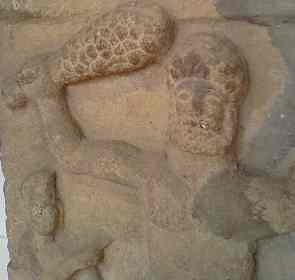
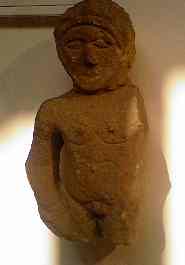 Above you’re looking at Hercules killing a (missing) Hydra, left at Jupiter, and below Minerva. (Well, OK, Minerva is a little too far on the naive side…)
Above you’re looking at Hercules killing a (missing) Hydra, left at Jupiter, and below Minerva. (Well, OK, Minerva is a little too far on the naive side…)
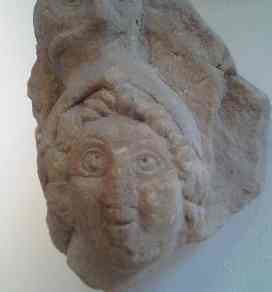
Among the most moving items are the gravestones for two small children (quite a blow to those who claim a lack of affective relationships in ancient families). Below is that of Vellibia Ertola (the latter name may have been her nickname),” who lived most happily four years and 60 days”. She holds a ball awkwardly, childishly. It stands some five-feet tall in total, and must have cost “Sudrenus” (her father?), who set it up, an awful lot.
(Bonus: an article on the women of Corbridge.)
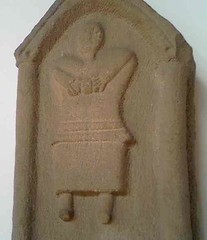
Out on the actual site, there are the usual military-style granaries, with raised floors, which were designed to allow for air circulation and keep the grain cool. (Also, so it is said, to allow small dogs and cats to keep down the vermin.)
The amount that the main road (actually part of Stanegate) was raised over nearly four centuries of settlement is clear from the six-foot or more drop down to the loading level of the granaries. Further up is a fascinating structure – probably an early example of local government ambition outstripping its capabilities. A huge rectangular walled area was laid out, to be surrounded by buildings, probably as a grand market, but the structures on at least two sides were never completed.
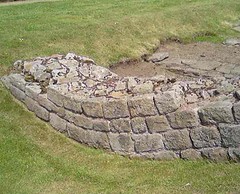 Another fascinating aspect of the site is its topography. As is usual, a couple of wooden forts were built on the site before the stone structures, which were overlayed over their filled-in, but inadequately compacted, ditches. They’ve since subsided, but it is a tribute to the Roman mason’s art that the walls have sagged into them, but generally held together.
Another fascinating aspect of the site is its topography. As is usual, a couple of wooden forts were built on the site before the stone structures, which were overlayed over their filled-in, but inadequately compacted, ditches. They’ve since subsided, but it is a tribute to the Roman mason’s art that the walls have sagged into them, but generally held together.
Then, with the midday sun beating down, it was on my bike for a long, and initially pleasant run into Newcastle. The official cycleway 72 route follows the route, with the wall itself in the hills above, and since the lungs were still struggling with the cold, I was happy to stay in the flat, and sometime shade.
Along the way I passed the well-marked site of the Battle of Newburn Ford – part of the Second Bishops’ War, which preceded the English Civil War (and saw the Scots take Newcastle).
Then, all too soon, I was in Newcastle proper. Not the most pleasant bit of the ride, although when all of the roadworks along the main road are finished it will be marginally improved. I thought Hackney’s council tower blocks were bad, but these looked a lot worse. And back on the river, you’re in serious industrial territory – huge stacks of wrecked cars being moved around for the crushers, factories belching dubious-smelling fumes.
 Still, you’ve got to get to Wallsend really – the name says it all – and eventually, keeping pedalling slowly and steadily, I did, and here’s the picture to prove it…
Still, you’ve got to get to Wallsend really – the name says it all – and eventually, keeping pedalling slowly and steadily, I did, and here’s the picture to prove it…
And here’s the wall’s final museum (just behind that picture) – what was the fort of Segedunum. Not, unfortunately, however, in the trusty hands of English Heritage, but those of the local council. Don’t waste your money! The fort has been levelled to its foundations (for which the council perhaps can’t be blamed), but it can be blamed for the fact that the car park is made the focus of the site, in its centre; that the museum is an “interactive” insult to the intelligence that will bore anyone over the age of five; and that the whole has been finished off with a nine-storey glass tower that offers a (not) great view of the shipyards and the local housing estate.
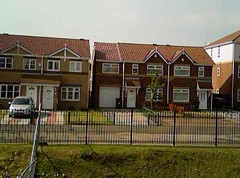 Ah yes, it does also boast a “reconstruction of the wall”, reached by crossing a very busy road that is not at all screened from the site. Climb that wall, and you’ll find the barbarians are indeed at the gates…
Ah yes, it does also boast a “reconstruction of the wall”, reached by crossing a very busy road that is not at all screened from the site. Climb that wall, and you’ll find the barbarians are indeed at the gates…
And the ride did get even worse. Don’t follow the official route to Whiteley Bay, if you’re doing the ride. It has no historical point to it, and its inclusion seems to merely be an attempt to support a distinctly decayed seaside resort whose chief claim to fame seems to be that it is Newcastle’s “party capital”. (Cheap jugs of alcohol a speciality.) Turn around and go back to accommodation in Newcastle, which will at least put you in close proximity to its excellent range of museums.
My memories of that final six or seven miles – decayed industrial estates, post-industrial wastelands, taunting local youths, graffitti, dodging broken glass while thinking “I really don’t want a puncture”. You might think I’m biased, since about 20m from the hotel a nasty piece of pavement (combined admittedly with my own exhaustion) caused me to tumble off the bike, nicely skin my knee and hit with my sternum at some speed with the pointy end of my handlebars – not an action I’d recommend). But I was at the time thinking about writing just this …
Nonetheless, it was a brilliant ride, and the story isn’t finished just yet, since tomorrow I stagger, admittedly a little unsteadily and under the influence of large quantities of ibuprofen, into the excellent Museum of Antiquities. (And I’m writing this some five days after the event, so well on the road to recovery.)

 About
About
One comment
Pingback: Ancient Avignon - Philobiblon